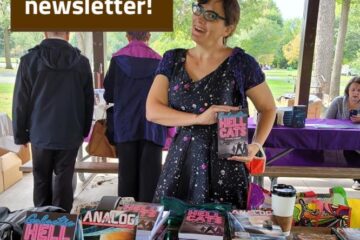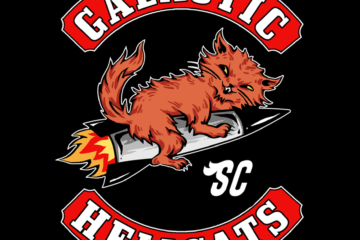For the Clarion write-a-thon in 2014, I offered to write a story to order for anyone who donated. My friend Brian Fergueson prompted me to write “Aztecs in Space.” I happily fell down a research hole and learned, among other things, that the planet Venus was associated with the feathered serpent deity Quetzalcoatl.
All I managed to write during that write-a-thon were some vague and plotless scenes of people talking about Aztec theology to each other, on a space ship. Sorry, Brian.
“Dude,” I asked him, “What did you really want from this story?”
“I just thought it’d be cool to have sun-worshipers out in space where they can’t see the sun,” he said.
I… had no idea what to do with that. I filed the story fragments away and moved on.
Then my friend Geoff Landis, a physicist for NASA, gave a talk on his proposal for colonizing Venus using, basically, floating cities. The air temperature and pressure on Venus are quite balmy if you just go high enough in their atmosphere!
(I should mention that Geoff’s in my writing workshop, The Cajun Sushi Hamsters from Hell. Also, he’s got Hugos on his mantlepiece. I’ve petted them.)
I read Geoff’s paper and decided, heck, I’m going to write a story that takes place on an aerostat colony over Venus. I immediately picked a construction worker protagonist, because I love construction worker protagonists and it made the building of the colony a visceral part of the story.
They were starting without a place to stand on. Which reminded me of my earlier research and the founding of Tenochtitlan — the Mexica people (whom we call Aztecs for weird reasons) founded their city on a marshy, barely solid island in the middle of a lake whose shores were already claimed. They had to take what was left, and build it up to support them.
By the time the next write-a-thon rolled around, I’d written a nice little adventure story where our heroine must save the failing hot air balloon supporting her colony, and I’d incorporated some of what I’d learned about Aztecs, making it sort of an answer to Brian’s original request. Roll credits, right? Not really.
Here’s where it gets rocky.
At the workshop session for the first draft, the first Hamster to critique listed off a laundry list of objections. “I don’t think their environment suits would be like that.” “The balloon wouldn’t behave like that.” “The atmosphere wouldn’t be like that.” Etc. Ouch, I thought. I had done so much research! How could I be so wrong? I wrote it all down and waited for Geoff’s turn.
This poor human went before Geoff, see, in our around-the-circle discussion. The next few people agreed, “Yeah, I didn’t have a problem with it when I was reading, but now that [person x] said that, this doesn’t seem right” or “I don’t think it would do that.” And then it was Geoff’s turn. Geoff has a reputation as a harsh critic. He won’t hold back if you make a physics mistake. I think he took it as a personal affront the one time I had a gun not fire because it was in vacuum. So I was braced. Geoff was either going to exonerate me or finish off the last thread of my ego.
He cleared his throat, glanced at the people to his right, and said, “Actually, the science all works out, and where Marie has made conjectures, they are plausible. It could use a B-plot, but Analog might take it as-is.”
I had not sold a story to Analog yet. I’d barely sold any stories. Geoff’s confidence meant a lot! I felt awash in triumph and, after minor tweaks, sent the story straight off to Analog.
Trevor Quachri wrote me the NICEST rejection letter.
“Great story! But we just had Venus as our cover story last month, so I can’t take it.”
I wasn’t even sad. That was the closest-to-an-acceptance I’d ever seen. I re-read the email over and over, thinking, “Yes. This story is good enough. It just wasn’t right for this moment.”
I sent it right off to Clarkesworld. And got a form rejection. Then the next market. Then the next, and so on for fifteen rejections.
At last, the story was accepted! Relief! It was an anthology looking specifically for near-future colonization stories with female leads. PERFECT.
Or so I thought. A few days after the acceptance, questions started coming in. “You gave the time of sunlight as just over two days – but the rotation of Venus is 243 days!”
“Yes,” I replied, “but the speed of the upper cloud layer’s rotation is faster than the planet below, just about four earth days! I’ll add a line explaining that.”
“Should there really be lightning on Venus?”
“Yes, here is the article about the discovery of lightening on Venus!”
“Shouldn’t the pressure be lighter at that altitude?”
“Here’s the article for that.”
“Shouldn’t the gravity be different?”
“Here’s the citation for that.”
After each question, of course, I edited the story to clarify the science points and sent the revised draft in with a promise to change anything they wanted me to.
Dozens of emails back and forth. I felt pretty good – after all, each question had an answer, and I was always willing to edit to critique. Surely this editor was very invested in the story now. But then I got the rug pulled out: “We’ve decided not to take your story after all.”
No explanation given.
I didn’t jump to conclusions and curse his name.
Ha ha, of course I did. “That jerk thinks his gut instincts are more important than researched facts! He couldn’t take it that I knew more about Venus than he did!”
Or not. Maybe he misunderstood me and I him, or it had nothing to do with the questions and everything to do with a cool new story taking my slot.
I licked my wounds, revised, and resubmitted. I ended up getting two more rejections of “We just didn’t believe the science” and I lost my nut.
I’d done so much research for this story! I included “based on research by Dr. Geoffrey A. Landis” in my cover letters! The hell?
Well, nothing to do but keep sending it out. F&SF wanted more of the family backstory. I added some. Asimov’s felt the ending wasn’t quite there. I tweaked.
21 rejections later, the story was stronger than ever, but I was out of places I could send it to. How could my hardest hard SF story, the one that Hugo Winning Geoff(tm) said was “good to go” on the first draft, keep failing to find a home?
Dejected and helpless, I recalled how nice that Analog rejection was. I went back and re-read it. Four years had passed! Maybe?
I decided to do two unthinkable things: email an editor directly and re-submit a story (if he said okay.)
He said okay, and I re-submitted, and now what began five years ago with what was really a request for sun worship without a sun turned into my sixth sale to Analog Science Fiction and Fact.
There is a lesson in here for writing hard science fiction — if your facts don’t line up with common perception, you really have to point out those facts, even if it means getting a little info-dumpy.
And never give up on a story you believe in. It will find its home.


